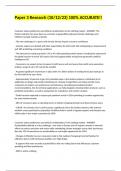Exam (elaborations)
Paper 3 Research (10/12/23) 100% ACCURATE!!
- Course
- Institution
Customer tastes preferences and ethical considerations in the clothing market - ANSWER- The fashion industry has never been so uncertain as geopolitical upheaval climate challenges and inflation has kept markets unsteady - The new challenges in a post covid climate directly impact consumer confide...
[Show more]



